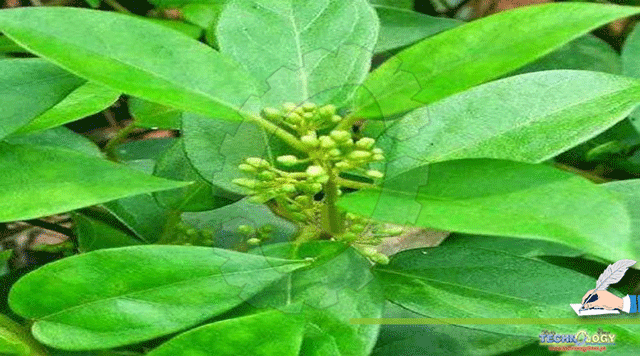Gymnema sylvestre (GURMAR) is a climbing shrub native to India and it belongs to Asclepidaceae. The word GURMAR meaning “the sugar killer”. The leaves of this plant consumed orally for treatment of diabetes in Ayurvedic medicines. They also lower serum cholesterol and triglycrides.plant extract (gymnemic acid) lowers blood sugar by stimulating release of the indigenous insulin stores. The gymnemic acid also blocks glucose receptors in the small intestine. A paste of the leaves is very useful in eye complaints and mycosis of toes. Roots and leaves are also used as remedy for snake bite.

By: Asif Mukhtiar, Maria Naqve, Muhamamd Anjum Zia, Athar Mahmood & Abdul Qudoos. University of Agriculture Faisalabad.
PRODUCTION TECHNOLOGY
Gymnema sylvestre reproduces by stem cutting and sexually by seeds. Seeds are sown in the month of November and December and are harvested after 8-9 months. Seed viability is very short but germinate best in coir dust.
TRADITIONAL USE OF GURMAR
Traditionally the leaves of Gymneme Sylvester are used for treatment of diabetes. Root bark is very useful in treating piles and an external application of root paste is useful in treatment of insect bites.
PHARMACOLOGICAL USES
The leaves of Gymnema sylvestre reduce urine glucose in diabetics Patient. In Animal gurmar leaf powder had positive effects over blood glucose levels. The gurmar powder is effective in lowering the fasting as well as postprandial blood glucose levels .
Gymnema sylvestre helps to promote weight loss through its ability to reduce cravings for sweets and control blood sugar levels. The gurmarin peptide block the ability to taste sweet or bitter flavors and thus reduces sweet cravings. Gymnema Sylvestre extract with hydroxycitric acid, niacin bound chromium can facilitate a reduction in excess body weight.
Gymnema sylvestre is effective against antiviral activity its contain chemical constituent, Gymnamic acid. Gymnamic acid A showed antiviral activity. Gymnamic acid A showed maximum activity against influenza virus at the concentration of 75mg/Kg body weight .
The ethanolic concentrate of Gymnema sylvestre leaves showed great antimicrobial activity against Bacillus pumilis, B. subtilis, Pseudomonas aeruginosa, and Staphylococcus aureus . Ethanolic, Chloroform and Ethyl acetate extracts of the aerial parts of G. sylvestre also have antibacterial effects against P. vulgaris, E. coli, P. aeroginosa, Klebsella pneumoniae and S.aureus .
Aqueous and petroleum ether extracts of Gymnema sylvestre is antiarthritic in arthritic Human. The antiarthritic activity is due to rich source of saponins, triterpenoids and steroid.
Methanol extract of Gymnema sylvestre prevents dental cries and use in toothpaste.
DOSAGE
Gymnema sylvestre is available in powder, extract paste and solid in normlize form capsule or tablets in combination with other herbal plant.
Adult dose: In liquid form (extract), 25 to 75 ml per week is recommended. Best results of this medicine will come after 6 to 12 months of continuous use. In tablet form, 8 to 12 g per day is recommended.
Phytochemistry
The leaves of Gymnema sylvestre contain triterpene saponins belonging to oleanane and dammarene classes. Oleanane saponins are gymnemic acids and gymnemasaponins, while dammarene saponins are gymnemasides. The leaves also contain resins, albumin, chlorophyll, carbohydrates, tartaric acid, formic acid, butyric acid, anthraquinone derivatives, inositole alkaloids, organic acid (5.5%), parabin, calcium oxalate (7.3%), lignin (4.8%), cellulose (22%).
The gymnemic acids contain several acylated (tiglolyl, methylbutyroyl etc.) derivatives of deacylgymnemic acid (DAGA) which is a 3-O-β-glucouronide of gymnemagenin (3β, 16β, 21β, 22α, 23, 28-hexahydroxy-olean-12-ene). The individual gymnemic acids (saponins) include gymnemic acids I-VII, gymnemosides A-F, gymnemasaponins. The presence of gymnemic acids, (+) quercitol, lupeol, (-) amyrin, stigma sterol etc. have been reported from G. sylvestre. A new flavonol glycoside namely kaempferol 3-O-beta-D-glucopyranosyl-(1–>4)- alpha-Lrhamnopyranosyl-(1–>6)-beta-D-galactopyranoside has also been found in aerial parts of G. sylvestre. Three new oleanane type triterpene glycosides i.e. beta-O-benzoylsitakisogenin 3-O-beta-D-glucopyranosyl (1–>3)-beta-D-glucuronopyranoside, the potassium salt of longiospinogenin 3-O-beta-D-glucopyranosyl (1–>3)-beta-D-glucopyranoside and the potassium salt of 29- hydroxylongispinogenin 3-O-beta-D-glucopyranosyl (1–>3)-beta-D-glucopyranoside along with sodium salt of alternoside II were isolated from an ethanol extract of the leaves of G. sylvestre.
Four new triterpenoid saponins, gymnemasins A, B, C and D isolated from the leaves of G. sylvestre were identified as 3-O-[beta-D-glucopyranosyl(1–>3)-beta-Dglucopyranosyl]-22-O-tiglyol-gymnemanol,3-O-[beta-D-glucopyranosyl(1–>3)-beta-D-glucuro – nopyranosyl]- gymnemanol, 3-O-beta-D-glucuronopyranosyl-22-O-tigloyl-gymnemanol and 3- O-beta-D-glucopyranosyl-gymnemanol respectively. The aglycone, gymnemanol, which is a new compound, was characterized as 3 beta-16 beta-22 alpha-23-28-pentahydroxyolean-12-ene. Gymnestrogenin, a new pentahydroxytriterpene from the leaves of G. sylvestre has been reported.

Mechanism of action
Type-1 diabetes (IDDM; Insulin dependent diabetes mellitus) is an auto immune disease that occurs due to destruction of β-cells of the pancreas resulting in insulin deficiency. The patients with type-1 diabetes depend on a continuous supply of insulin from outside.
Type-2 diabetes mellitus is the world’s fastest growing metabolic disease and covers about 90% of diabetic population. This results in insulin resistance and obesity in patients. Type-2 diabetes results in polymorphism, activating multiple genes which encode different proteins, reducing in insulin production. Oral intake of Gymnema sylvestre results in reduction in glucose in urine in diabetic patient. Gurmar leaf powder has positive and encouraging effects over blood glucose level. The leaf extract when administrated to diabetic patient, stimulates the pancreas which in turn results in increase in insulin release. These compounds also results in fecal excretion of cholesterol. Studies also show that gurmar also passes some hypoglycemic acid effects. I.e. it helps in regeneration of islet cells, it enhances insulin secretion, reduce the glucose absorption in intestine, it increase the utilization of glucose by insulin dependent pathways, it also helps in increase in phosphorylase activity, decrease in glycogenic enzymes and sorbitol dehydrogenase. All these mechanism controlled by Gymnema sylvestre are helpful for antidiabetic activity.
Toxicity and side effects
Extract of Gymneme sylvestre shoots have shown antibacterial, antifungal, antiprotozoal, antiviral and hypoglycemic activity. But when G.sylvestre juice is taken in empty stomach it can cause gastrointestinal disorders. Excess dose can cause hypoglycemia in susceptible individuals.
Authors: Asif Mukhtiar, Maria Naqve, Muhamamd Anjum Zia, Athar Mahmood & Abdul Qudoos. University of Agriculture Faisalabad.